Access for All: The 5 W’s of Inclusive Marketing & Outreach for Transit Planning Programs
Date Published: March 11, 2022By: DeBrittany Mitchell, MA | Institute for Community Inclusion
Transit Planning 4 All highlights best practices for the inclusion and active involvement of older adults and people with disabilities in transit planning efforts nationwide. Effective and accessible marketing and outreach is a key factor in the success and sustainability of transit planning projects. This blog post explores the “5 W’s”- the who, what, when, where, and why– of accessible marketing and outreach efforts for transit planners.
1. WHO benefits from accessible marketing and outreach efforts?
Accessible marketing and outreach strategies are key to reaching and meaningfully engaging as many people as possible to have the greatest impact. It is especially critical to include people with all types of disabilities, such as those with auditory, cognitive, neurological, physical, speech, and visual disabilities. One key aspect of accessible marketing and outreach is ensuring that websites, tools, and technologies are designed and developed so that people with disabilities can perceive, understand, navigate, and engage.
Accessible marketing and outreach also benefit people without disabilities who face barriers to active participation (e.g., people with slow internet connection, smart phone users, older adults with changing abilities, people with situational limitations, and people with temporary disabilities). It is of utmost importance to design inclusive programs and engagement strategies that every individual can easily access, -regardless of disability.
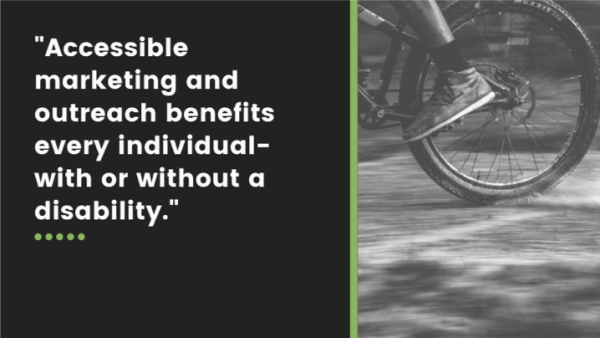
2. WHAT are some accessibility standards for marketing and outreach materials?
Ensuring accessibility is not only the right thing to do, it’s mandatory! There are requirements for website accessibility and Americans with Disabilities Act (ADA) compliance. For example:
- Your websites should adhere to Website Content Accessibility Guidelines (WCAG) standards
- Make all PDFs 508 compliant
- Include alternative text (alt text) in all digital images
- Check all content for contrast, text size, font, and reading/comprehension level
- Hold all in-person events s in accessible spaces and embrace inclusive language
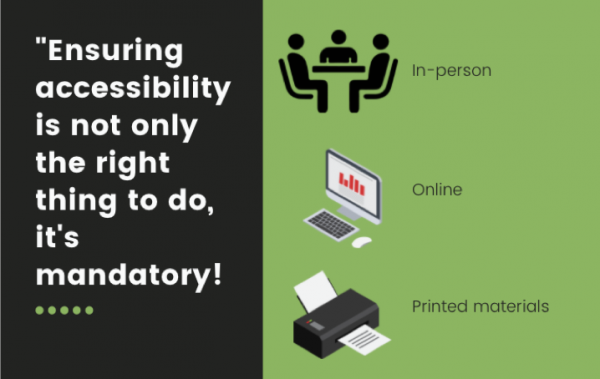
3. WHEN should you evaluate your efforts?
Measures for inclusion and accessibility should be a key factor throughout the life of the project, from the beginning planning stages to the end. Whether you are writing a document, preparing presentation slides, or creating a website, consider the clarity and navigability of the outreach materials from the start. Before finalizing your materials, test them with your audience and review to both verify compliance standards are met and ensure a high degree of accessibility across audiences. For example, be sure to check written documents for proper labeling and formatting, ensure visuals are accurately described through alt text, and include captions for audio products.
4. WHERE do you cross-market to expand your reach?
When planning for marketing and outreach efforts for your transit initiative, be sure to include disability-specific and older-adult specific organizations, support groups, family groups, statewide independent living councils, older adults, people with disabilities, and their families. Partnering with these entities can lead to increased engagement and trust between transit planning programs and the communities they serve. Below is a list of examples of local and national organizations to consider partnering with to better reach individuals with disabilities and older adults.
- Centers for Independent Living (CILs) are consumer-controlled, community-based, cross-disability, nonresidential, private non-profits designed and operated within a local community by individuals with disabilities. CILs provide an array of independent living services.
- National Federation of the Blind is the oldest and largest nationwide organization of blind Americans and consists of affiliates, chapters, and divisions. It defends the rights of blind people of all ages and provides information and support to families with blind children, older Americans who are losing vision, and others.
- ADAPT is a national grass-roots community organization that organizes disability rights activists to engage in nonviolent, direct action to assure the civil and human rights of people with disabilities to live in freedom.
- Parent to Parent (P2P) is a national nonprofit organization that promotes excellence in P2P programs across the nation and provides emotional and informational support to families by connecting parents of children with disabilities or special health care needs.
- University Centers for Excellence in Developmental Disabilities are centers that exchange information between the disability communities and universities across the US.
- Self-Advocates Becoming Empowered is a national self-advocacy organization that focuses on equal rights for individuals with disabilities.
- National Alliance on Mental Illness (NAMI) is the nation’s largest grassroots mental health organization.
- USAging is the national network of Area Agencies on Aging and advocates for the Title VI Native American Aging Programs
5. WHY should accessibility matter to transit planners?
Ensuring accessibility can be a process of trial and error. Monitoring the access, usefulness, and impact of marketing and outreach materials for transit planning efforts and being responsive to feedback can make all the difference in moving toward better equity and inclusion. Inequitable access to information can lead to injustice when it comes to transit investments and conditions. Regardless of the marketing and outreach materials and tools you use, the most critical determinants of success are whether the process of marketing and outreach results in a high level of participation fully representative of the community, including older adults and people with disabilities.
Related Content:

Keep Public Engagement Going
By Charles Dickson The recent crises surrounding COVID-19 has upended business as usual across the board. Especially challenged has been…
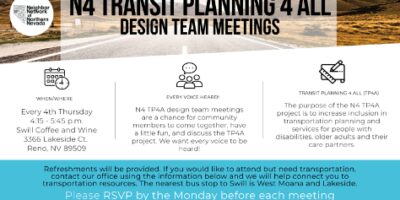
Project Spotlight #4: N4’s Inclusive Design Team
The whole of inclusive planning is made up of many parts – small practices that often have an outsized impact…

Webinar: Inclusive Transportation – The Long Game with Veronica Davis
The Ohio State University’s Center for Urban and Regional Analysis (CURA) and the Kirwan Institute hosted a webinar on inclusive…
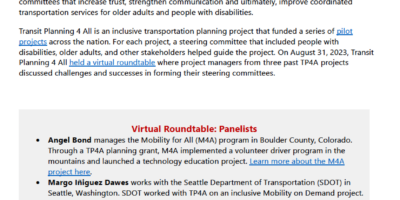
Steering Towards Inclusion: Lessons Learned on Steering Committees for Inclusive Transit Planning
On August 31, 2023, Transit Planning 4 All held a virtual roundtable where project managers from three past TP4A projects…
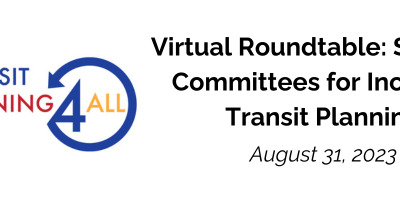
Virtual Roundtable: Steering Committees for Inclusive Transit Planning
Date: August 31, 2023 How do you form a successful steering committee? This 1-hour roundtable explored inclusive strategies and lessons…
